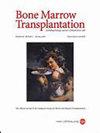Riad El Fakih, Mohamed I Sharif, Shaykhah Alotaibi, Abdulrahman Almujalli, Sara Samarkandi, Salman Almhareb, Yasamiyan Saud Alsgaih, Feras Alfraih, Saud Alhayli, Syed Osman Ahmed, Marwan Shaheen, Naeem Chaudhri, Fahad Alsharif, Amr Hanbali, Ayman Saad, Abdullah Alamer, Alfadel Alshaibani, Mansour Alfayez, Abdulwahab A Albabtain, Hanan Alkhaldi, Ahmad S Alotaibi, Tusneem Elhassan, Fahad Almohareb, Ali Alahmari, Ghulam Mufti, Walid Rasheed, Hazzaa Alzahrani, Mahmoud Aljurf
求助PDF
{"title":"人类白细胞抗原匹配的近亲与非近亲兄弟姐妹移植的结果,单中心经验。","authors":"Riad El Fakih, Mohamed I Sharif, Shaykhah Alotaibi, Abdulrahman Almujalli, Sara Samarkandi, Salman Almhareb, Yasamiyan Saud Alsgaih, Feras Alfraih, Saud Alhayli, Syed Osman Ahmed, Marwan Shaheen, Naeem Chaudhri, Fahad Alsharif, Amr Hanbali, Ayman Saad, Abdullah Alamer, Alfadel Alshaibani, Mansour Alfayez, Abdulwahab A Albabtain, Hanan Alkhaldi, Ahmad S Alotaibi, Tusneem Elhassan, Fahad Almohareb, Ali Alahmari, Ghulam Mufti, Walid Rasheed, Hazzaa Alzahrani, Mahmoud Aljurf","doi":"10.1038/s41409-025-02609-y","DOIUrl":null,"url":null,"abstract":"<p><p>Matching HLA between donor and recipient pairs significantly improves engraftment and decreases GvHD. However, even in HLA matched siblings, the risk of graft failure and GvHD still exist and is partially attributed to the bidirectional alloreactivity generated from minor histocompatibility antigens (miHA) mismatching between donors and recipients. Consanguineous marriage increases the chance of miHA matching. This fact may be an advantage or disadvantage in consanguineous MSD transplants. We retrospectively reviewed our institutional transplant registry and selected AML and ALL patients who received a MSD allo-HCT between January 2006 and December 2020. The objective was to compare the outcomes of transplant among consanguineous vs non-consanguineous pairs. Analysis was conducted using RStudio. Version 1.4.1106 © 2009-2021 RStudio, PBC. 271 patients met the eligibility criteria were included in this study. Sixty-three were consanguineous and 208 were not. The median follow-up time was 72.6 months. The five years OS and DFS were not statistically different between consanguineous and non-consanguineous group. A trend toward a higher relapse rate in the consanguineous group was observed. The five years NRM for the whole group was 10.5% with no statistically significant difference between groups. The grade II-IV aGvHD incidence was 25.8% for the whole group with no statistically significant difference between groups. The all grade cGvHD incidence was 52.8% with no statistically significant difference between groups. Populations with high levels of consanguinity, complex consanguinity loops often arise from cousin marriages across multiple generations. This means that even individuals who consider themselves non-consanguineous may still share genetic traits associated with consanguinity. Therefore, high level of homozygosity probably exist in the non-consanguineous cohort and explain these results.</p>","PeriodicalId":9126,"journal":{"name":"Bone Marrow Transplantation","volume":" ","pages":""},"PeriodicalIF":4.5000,"publicationDate":"2025-04-29","publicationTypes":"Journal Article","fieldsOfStudy":null,"isOpenAccess":false,"openAccessPdf":"","citationCount":"0","resultStr":"{\"title\":\"Outcomes of human leukocyte antigen matched sibling transplant from consanguineous versus non-consanguineous parents, a single center experience.\",\"authors\":\"Riad El Fakih, Mohamed I Sharif, Shaykhah Alotaibi, Abdulrahman Almujalli, Sara Samarkandi, Salman Almhareb, Yasamiyan Saud Alsgaih, Feras Alfraih, Saud Alhayli, Syed Osman Ahmed, Marwan Shaheen, Naeem Chaudhri, Fahad Alsharif, Amr Hanbali, Ayman Saad, Abdullah Alamer, Alfadel Alshaibani, Mansour Alfayez, Abdulwahab A Albabtain, Hanan Alkhaldi, Ahmad S Alotaibi, Tusneem Elhassan, Fahad Almohareb, Ali Alahmari, Ghulam Mufti, Walid Rasheed, Hazzaa Alzahrani, Mahmoud Aljurf\",\"doi\":\"10.1038/s41409-025-02609-y\",\"DOIUrl\":null,\"url\":null,\"abstract\":\"<p><p>Matching HLA between donor and recipient pairs significantly improves engraftment and decreases GvHD. However, even in HLA matched siblings, the risk of graft failure and GvHD still exist and is partially attributed to the bidirectional alloreactivity generated from minor histocompatibility antigens (miHA) mismatching between donors and recipients. Consanguineous marriage increases the chance of miHA matching. This fact may be an advantage or disadvantage in consanguineous MSD transplants. We retrospectively reviewed our institutional transplant registry and selected AML and ALL patients who received a MSD allo-HCT between January 2006 and December 2020. The objective was to compare the outcomes of transplant among consanguineous vs non-consanguineous pairs. Analysis was conducted using RStudio. Version 1.4.1106 © 2009-2021 RStudio, PBC. 271 patients met the eligibility criteria were included in this study. Sixty-three were consanguineous and 208 were not. The median follow-up time was 72.6 months. The five years OS and DFS were not statistically different between consanguineous and non-consanguineous group. A trend toward a higher relapse rate in the consanguineous group was observed. The five years NRM for the whole group was 10.5% with no statistically significant difference between groups. The grade II-IV aGvHD incidence was 25.8% for the whole group with no statistically significant difference between groups. The all grade cGvHD incidence was 52.8% with no statistically significant difference between groups. Populations with high levels of consanguinity, complex consanguinity loops often arise from cousin marriages across multiple generations. This means that even individuals who consider themselves non-consanguineous may still share genetic traits associated with consanguinity. Therefore, high level of homozygosity probably exist in the non-consanguineous cohort and explain these results.</p>\",\"PeriodicalId\":9126,\"journal\":{\"name\":\"Bone Marrow Transplantation\",\"volume\":\" \",\"pages\":\"\"},\"PeriodicalIF\":4.5000,\"publicationDate\":\"2025-04-29\",\"publicationTypes\":\"Journal Article\",\"fieldsOfStudy\":null,\"isOpenAccess\":false,\"openAccessPdf\":\"\",\"citationCount\":\"0\",\"resultStr\":null,\"platform\":\"Semanticscholar\",\"paperid\":null,\"PeriodicalName\":\"Bone Marrow Transplantation\",\"FirstCategoryId\":\"3\",\"ListUrlMain\":\"https://doi.org/10.1038/s41409-025-02609-y\",\"RegionNum\":2,\"RegionCategory\":\"医学\",\"ArticlePicture\":[],\"TitleCN\":null,\"AbstractTextCN\":null,\"PMCID\":null,\"EPubDate\":\"\",\"PubModel\":\"\",\"JCR\":\"Q1\",\"JCRName\":\"HEMATOLOGY\",\"Score\":null,\"Total\":0}","platform":"Semanticscholar","paperid":null,"PeriodicalName":"Bone Marrow Transplantation","FirstCategoryId":"3","ListUrlMain":"https://doi.org/10.1038/s41409-025-02609-y","RegionNum":2,"RegionCategory":"医学","ArticlePicture":[],"TitleCN":null,"AbstractTextCN":null,"PMCID":null,"EPubDate":"","PubModel":"","JCR":"Q1","JCRName":"HEMATOLOGY","Score":null,"Total":0}
引用次数: 0
引用
批量引用

 求助内容:
求助内容: 应助结果提醒方式:
应助结果提醒方式:


